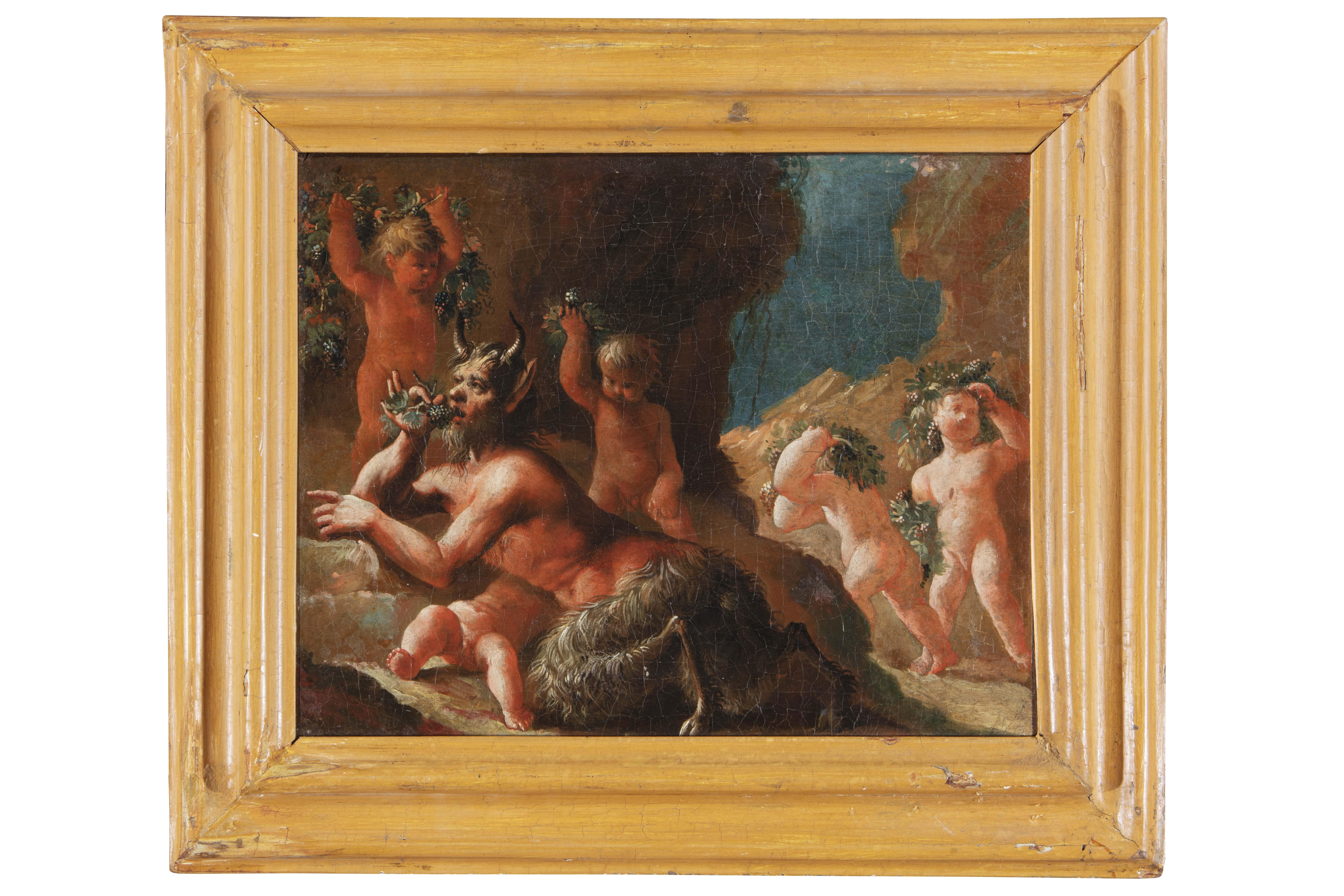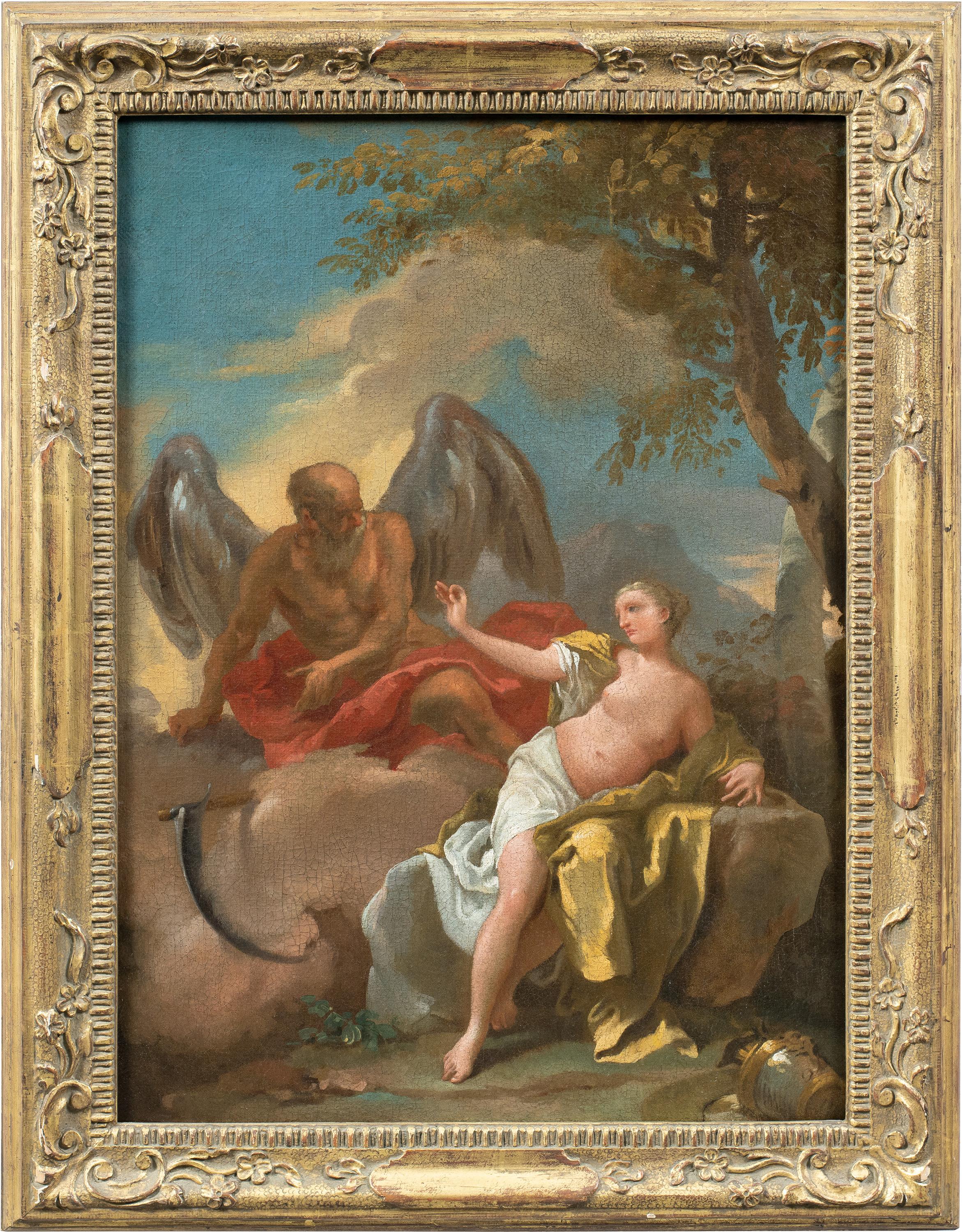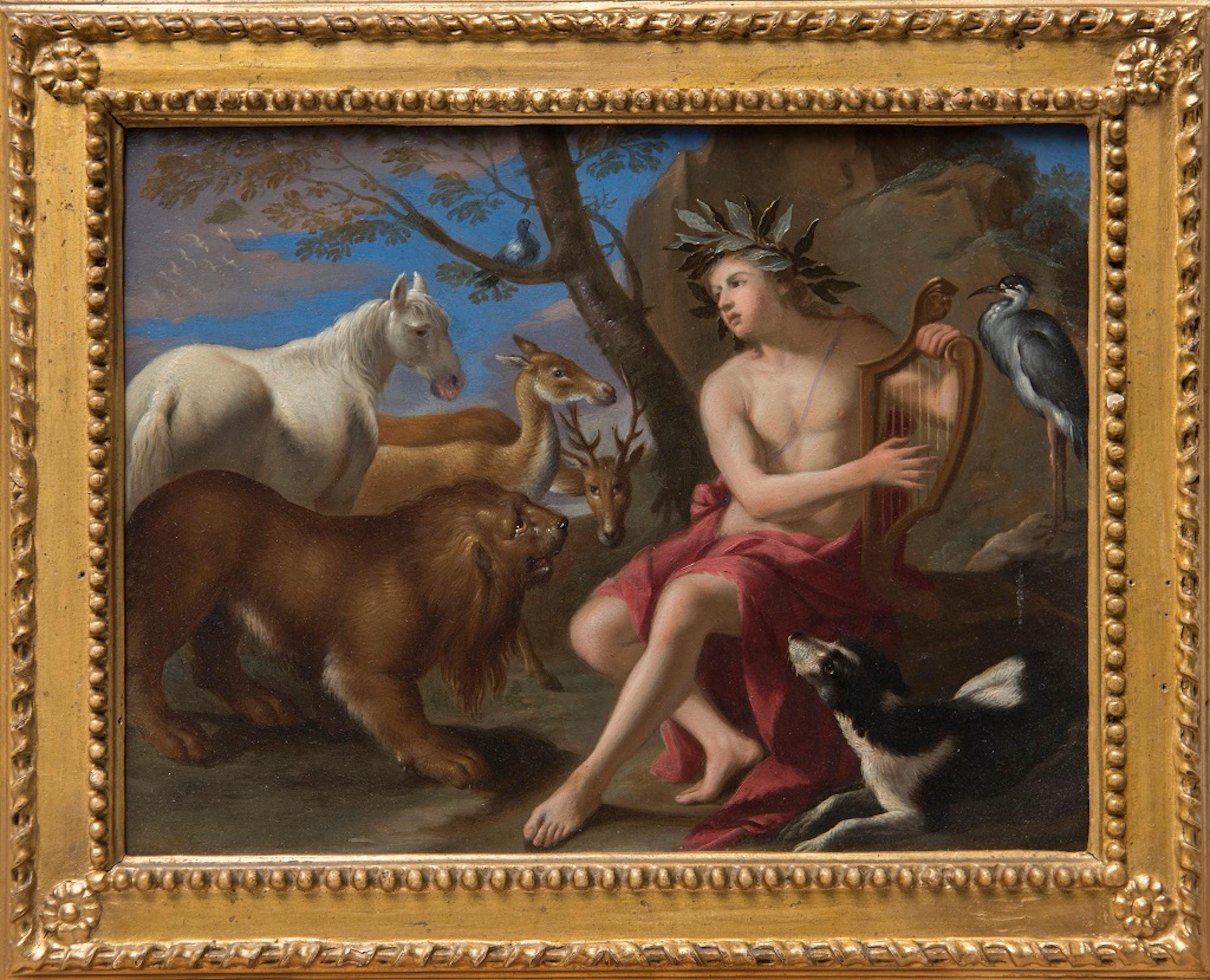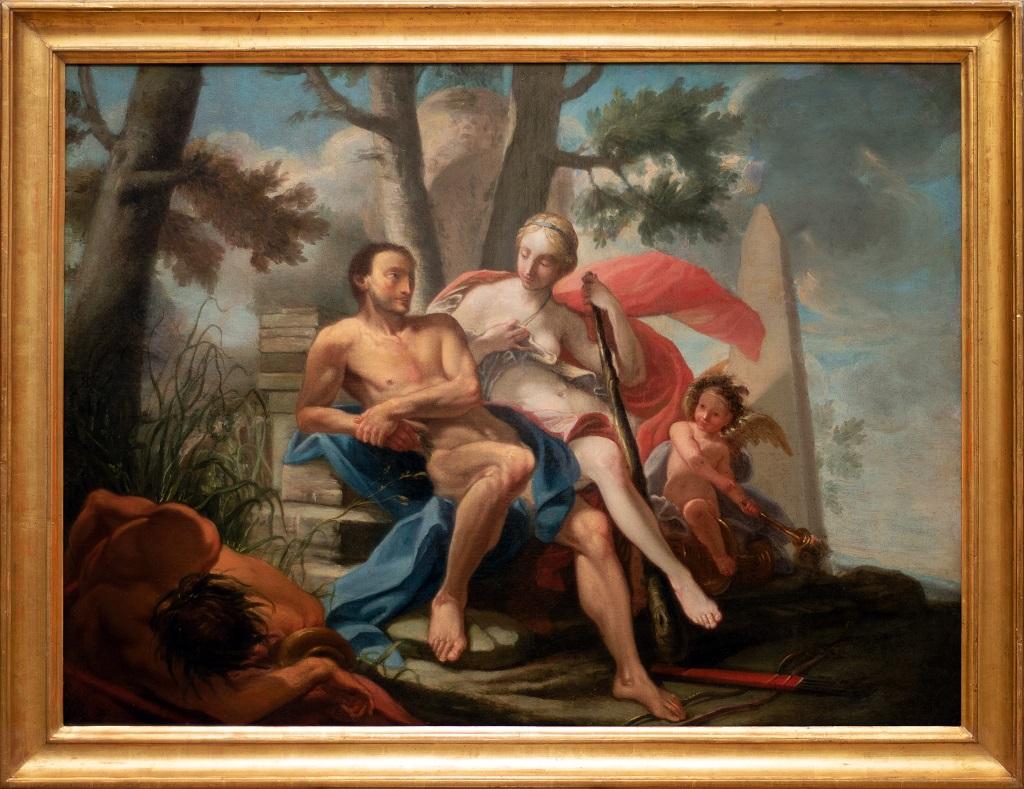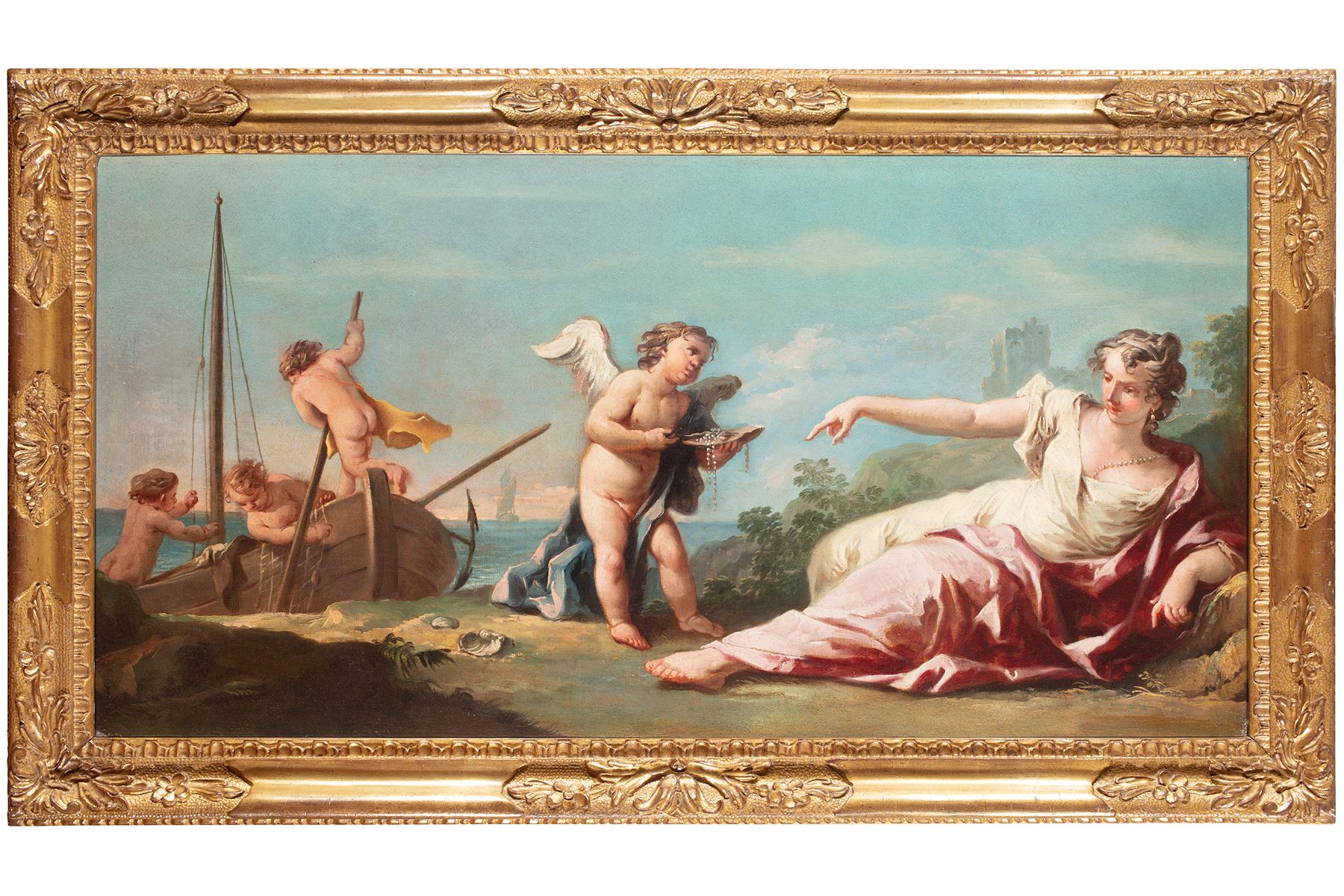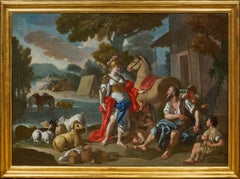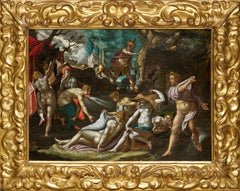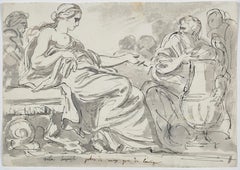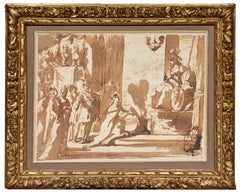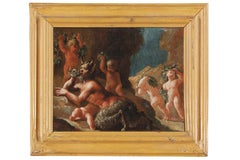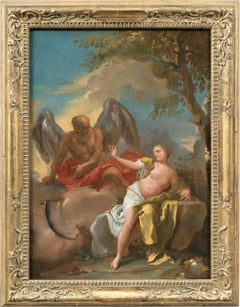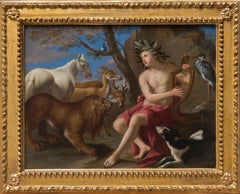Items Similar to Mercury and Io, a rediscovered painting by Jean-Baptiste Marie Pierre (ca. 1740)
Video Loading
Want more images or videos?
Request additional images or videos from the seller
1 of 12
Jean-Baptiste Marie PierreMercury and Io, a rediscovered painting by Jean-Baptiste Marie Pierre (ca. 1740)Circa 1740
Circa 1740
$62,784.32
£46,673.17
€52,500
CA$87,582.74
A$95,007.49
CHF 49,960.24
MX$1,156,049.08
NOK 624,583.54
SEK 589,058.98
DKK 399,819.32
About the Item
We would like to thank Mr. Nicolas Lesur for confirming the autograph nature of the entire composition after a direct examination of the painting on November 27, 2024.
This painting dates from the early years following Jean-Baptiste Marie Pierre's return to Paris after his stay in Rome. This artwork is a rediscovery: it had been largely distorted by an invasive restoration carried out during the 20th century, which had integrated our flute-player into a landscape, masking both the thatched cottage on the right and, above all, the cow on the left. This cow is however crucial to understanding the significance of this bucolic scene, as it probably depicts Mercury, disguised as a shepherd, playing the flute to lull to sleep the terrible Argos. Argos was the guardian of Io, the priestess of Juno beloved of Jupiter, who transformed her into a heifer to escape the wrath of his wife Juno...
1. The stay in Rome, a key stage in the life of Jean-Baptiste Marie Pierre
Jean-Baptiste Marie Pierre was born in Paris on March 6, 1714 into a wealthy family of goldsmiths and jewelers. His father Jean Pierre was elected alderman in 1743, which ennobled him. This family affluence gave him access to academic studies with a tutor. Pierre became a pupil of painter Nicolas Bertin (1668-1736), then of Charles-Joseph Natoire (1700-1777). He attended the Académie Royale de Peinture et de Sculpture, where he made friends with the engraver Charles-Nicolas Cochin le Fils (1715 - 1790). This friendship also led him to frequent the workshop of Cochin le Père (1688 - 1754), from whom he undoubtedly learned engraving and who introduced him to the art of Watteau.
In 1734, he won the Académie's Grand Prix for painting, with Sanson, whose Hair is cut by Dalila (current whereabouts unknown). He was then authorized to join the Académie de France in Rome, which was at that time under the direction of the painter Nicolas Vleughels (1688-1737). He stayed in Rome from June 1735 to June 1740.
Returning to Paris in 1740, he enjoyed great success and in 1752 became the first painter to the Duke of Orléans, for whom he painted several ceilings at the Palais-Royal and at the Château de Saint-Cloud. Between 1752 and 1757, he also painted two domes for the church of Saint-Roch in Paris. He became Premier Peintre du Roi (First Painter to the King) in 1770, following in the footsteps of François Boucher, and exerted a decisive influence on the art and artists of his time. He reserved his painting talents exclusively for royal commissions, and died on May 15, 1789, on the eve of the French Revolution.
2. A subject in the middle between bambochade and mythology ...
At first glance, the theme depicted here evokes a bambochade, one of those scenes of daily life widely represented in Pierre's work, particularly after his return from Italy in 1740. We present in the Gallery (6th picture) an example with A Bridge, a painting dated 1749 from the Louvre Museum.
A closer look at our painting, however, reveals a different subject: our shepherd looks quite noble for a simple shepherd, his legs draped in a red stole, the purple evoking more the imperial dignity rather than the garb of a simple shepherd. His elegant sandals evoke the talaria, Mercury's famous winged sandals.
The cow on his left has a striking feature: an udder that appears to have only one teat, making it more reminiscent of a (generous) woman's bosom than an animal's udder! Our heifer (without its udder) is very close in composition to a drawing of two oxen harnessed together, made by Pierre during his stay in Italy and now preserved in the Library of the National Institute for Archeology and Art History in Rome.
This scene is reminiscent of the legend of Io and Jupiter: Jupiter, having been caught with Io by Juno, transforms her into a heifer and offers her to his wife, who in turn entrusts her to the care of the terrible Argos, the giant with fifty pairs of eyes. Jupiter then sends Mercury to free the poor Io. Mercury manages to lull Argos to sleep with sweet music and decapitates him, allowing Io to escape.
The theme of Mercury and Argos was dealt with by Pierre, and it is entirely possible that our painting, whose form and composition are fairly typical of a door top, was part of a larger ensemble featuring other mythological scenes, which has not been identified at this stage.
3. A spectacular rediscovery
A picture taken under ultra-violet light (7th picture in the gallery) shows the extent of the overpainting that had been added to transform it into an easel painting, to accredit the idea that it had been painted by Claude Lorrain! These additions appear very clearly on both sides of the flute player and in the black-colored areas, while the original parts disappear under a blue fluorescence due to the presence of the old varnish. No element of the original composition hidden beneath the overpainting was visible on infrared reflectography, all the additions having been made with acrylic paint applied directly over the particularly thick varnish.
Removal of the overpaint has gradually revealed the original composition, as we can see in the last photo in the Gallery, which reveals the appearance of our heifer's horn and ear.
The meticulous cleaning has restored the composition in its entirety, just as it had been conceived by Pierre, with a great freedom of touch and a vigor characteristic of his art on his return from Italy in the 1740's. The restoration has also revealed the painting's beautiful golden light.
We have kept and restored the carved and gilded wooden frame of this painting, which was probably executed using moldings from wood paneling.
Main bibliographical reference :
Nicolas Lesur - Olivier Aaron - Jean-Baptiste Marie Pierre 1714-1789 Premier peintre du roi - Arthena 2009
- Creator:Jean-Baptiste Marie Pierre (1714 - 1789, French)
- Creation Year:Circa 1740
- Dimensions:Height: 34.5 in (87.63 cm)Width: 53.13 in (134.96 cm)
- Medium:
- Movement & Style:
- Period:1740-1749
- Condition:30 7/8’’ x 49 5/8’’ (78.5 x 126 cm) - Framed: 34 1/2'' x 53 1/8" (87.5 x 135 cm).
- Gallery Location:PARIS, FR
- Reference Number:1stDibs: LU1568216084092
About the Seller
5.0
Vetted Professional Seller
Every seller passes strict standards for authenticity and reliability
Established in 2020
1stDibs seller since 2021
10 sales on 1stDibs
- ShippingRetrieving quote...Shipping from: PARIS, France
- Return Policy
Authenticity Guarantee
In the unlikely event there’s an issue with an item’s authenticity, contact us within 1 year for a full refund. DetailsMoney-Back Guarantee
If your item is not as described, is damaged in transit, or does not arrive, contact us within 7 days for a full refund. Details24-Hour Cancellation
You have a 24-hour grace period in which to reconsider your purchase, with no questions asked.Vetted Professional Sellers
Our world-class sellers must adhere to strict standards for service and quality, maintaining the integrity of our listings.Price-Match Guarantee
If you find that a seller listed the same item for a lower price elsewhere, we’ll match it.Trusted Global Delivery
Our best-in-class carrier network provides specialized shipping options worldwide, including custom delivery.More From This Seller
View AllErminia and the Shepherds, a painting by Francesco de Mura (Napoli 1696 - 1782)
By Francesco de Mura
Located in PARIS, FR
In this masterly painting, Francesco de Mura presents the meeting of Erminia and the shepherds, a famous episode taken from the seventh canto of Torquato Tasso's Jerusalem Delivered....
Category
1760s Old Masters Figurative Paintings
Materials
Canvas, Oil
Diana and Actaeon, a Mannerist painting after Joseph Heintz the Elder
Located in PARIS, FR
This painting seduced us with its rich colors. Depicting Diana and her companions surprised by Actaeon, it was inspired by an engraving by Aegidius Sadeler II after a painting by Jos...
Category
17th Century Old Masters Nude Paintings
Materials
Oil, Wood Panel
Study in the Antique Style, a neoclassical drawing by Augustin Pajou
Located in PARIS, FR
In this lively and fresh drawing, probably taken from one of the artist's notebooks, Pajou presents us with a composition freely inspired by antiquity, as a souvenir of a visit to th...
Category
1750s Old Masters Figurative Drawings and Watercolors
Materials
Ink
Allegory of the Treaty of Angoulême, a drawing attributed to Donato Mascagni
Located in PARIS, FR
We would like to thank Mrs. Ursula Verena Fischer Pace for suggesting the attribution to Donato Arsenio Mascagni.
We were immediately seduced by the rich tonalities of this allegory...
Category
1620s Old Masters Figurative Drawings and Watercolors
Materials
Ink
Macbeth and the Three Witches a Painting on Panel by Francesco Zuccarelli
By Francesco Zuccarelli
Located in PARIS, FR
This painting, created during Zuccarelli's stay in England, represents the decisive moment when Macbeth, together with Banquo, meets the three witches who announce that he will be Ki...
Category
1760s Old Masters Landscape Paintings
Materials
Oil, Wood Panel
Frieze of antique figures, a drawing by the sculptor Antoine-Denis Chaudet
Located in PARIS, FR
Faithful to the neo-classical taste, sculptor Antoine-Denis Chaudet presents us with a frieze of antique figures executed in gray wash over pencil strokes, which is likely inspired b...
Category
Early 1800s Old Masters Figurative Drawings and Watercolors
Materials
Paper, Pencil, Ink
You May Also Like
18th century By French Maestro Bacchanal Oil on canvas
Located in Milano, Lombardia
18th Century French Maestro
Title: Bacchanal
Medium: Oil on canvas
Dimensions: without frame 24 x 30 cm - with frame 33.5 x 39 cm
Antique shaped wooden frame lacquered in mustard col...
Category
18th Century Old Masters Figurative Paintings
Materials
Oil, Canvas
$10,715 Sale Price
20% Off
Rococò Venetian Master - 18th century figure painting - Venus and Chronos
Located in Varmo, IT
Venetian painter (18th century) - Venus and Chronos (preparatory sketch).
59 x 43 cm unframed, 70 x 54 cm with frame.
Antique oil painting on canvas, in a carved and gilded wooden ...
Category
Mid-18th Century Rococo Landscape Paintings
Materials
Canvas, Oil
$4,788 Sale Price
50% Off
Orpheus - Original Oil on Canvas Attr. to Tommaso Salini - Early 17th Century
By Tommaso Salini
Located in Roma, IT
Orpheus is an original artwork realized in the first decades of the XVII century and attributed to the Italian master Tommaso Salini.
Oil painting on canvas.
A golden wood frame is...
Category
Early 17th Century Baroque Figurative Paintings
Materials
Oil
Hercules and Omphale - Oil Painting on Canvas - 18th Century
Located in Roma, IT
Hercules and Omphale is an original painting realized in France between the end of the 18th and the beginning of the 19th Century.
Original oil painting on canvas. Dimensions: 73 x...
Category
Late 18th Century Modern Figurative Paintings
Materials
Canvas, Oil
18th Century by Gaspare Diziani Venus With Cupid Oil on Canvas
By Gaspare Diziani
Located in Milano, Lombardia
Gaspare Diziani (Belluno, Italy, 1689 - Venice, Italy, 1767)
Title: Venus with Cupid
Medium: Oil on canvas
Dimensions: without frame 50 x 98 cm - with frame 64 x 112 cm
Gilded, carved and sculpted wooden cassetta frame...
Category
Early 18th Century Old Masters Landscape Paintings
Materials
Canvas, Cotton Canvas, Oil
$30,375 Sale Price
20% Off
PERSEO AND ANDROMEDA- In the Manner of A.R. Mengs- Italy- Figurative Painting
By Eugenio De Blasi
Located in Napoli, IT
Perseo and Andromeda - Oil on canvas cm.120x80, Eugenio De Blasi, Italy, 2005.
Gold gilded wooden frame available on request
This is his reinterpretation of a large ancient painting...
Category
Early 2000s Old Masters Figurative Paintings
Materials
Canvas, Oil
